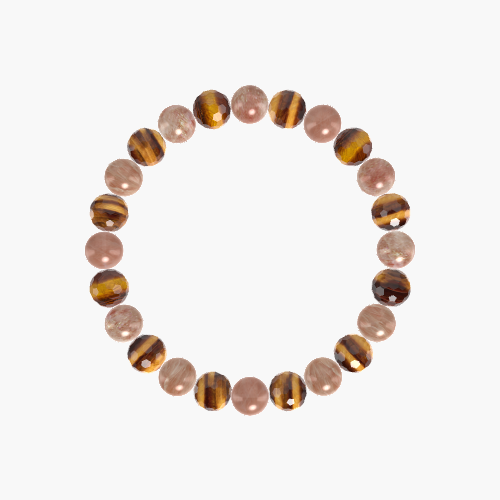Sunstone
Joy Leadership Positivity Confidence Prosperity
About Sunstone
Sunstone, a gemstone celebrated for its dazzling aventurescence, is a member of the feldspar family. This unique characteristic gives it a glittering effect reminiscent of the sun, hence its name. Known for its warm shades ranging from orange to red and brown, Sunstone embodies joy, vitality, and originality, making it a favorite among gemstone enthusiasts and collectors.
Physical and Geological Properties
Sunstone is primarily composed of oligoclase, a type of feldspar mineral, which gives it a hardness of 6 to 6.5 on the Mohs scale. Its most distinctive feature is the presence of minute plate-like inclusions of copper or hematite, which are responsible for its shimmering aventurescence. These inclusions reflect light, causing the brilliant, sparkling effect that resembles sunlight. Sunstone deposits can be found in various locations around the world, including Norway, Canada, the United States, India, and Russia. The quality and intensity of the aventurescence can vary greatly, with some stones displaying a subtle glow and others a more pronounced sparkle.
Historical Background
The history of Sunstone dates back to ancient civilizations, where it was used in various decorative and ceremonial contexts. Its name and use are particularly noted in Norse mythology, where it was believed to be a navigational aid for Vikings, possibly due to its light-reflecting properties. In Native American cultures, Sunstone was used in medicine wheel rituals to connect with the healing light of the sun. The use of Sunstone in jewelry and ornamentation has been documented throughout history, with its popularity peaking during various periods.
Metaphysical Properties and Symbolic Meanings
Sunstone is believed to possess a number of metaphysical properties and symbolic meanings. It is associated with leadership, strength, and the ability to clear and energize the chakras, particularly the sacral and solar plexus chakras. As a stone of abundance, it encourages independence and originality and is thought to bring good luck and fortune. Sunstone is also linked to the zodiac signs of Leo and Libra, enhancing their innate qualities of leadership, vitality, and balance. It is not traditionally a birthstone but is often used as a personal talisman for its uplifting and energizing effects.
Pairing with Other Gemstones
Sunstone pairs beautifully with other semi-precious gemstones that complement its vibrant energy and color. It harmonizes particularly well with Moonstone, its feldspar cousin, creating a balance between masculine (solar) and feminine (lunar) energies. Labradorite, with its mystical shimmer, enhances Sunstone's magical qualities, while Clear Quartz amplifies its healing properties. Turquoise and Lapis Lazuli can add a contrast of color and additional layers of protection and wisdom, making for a powerful and aesthetically pleasing combination in jewelry designs.
Basic Care Instructions
Despite its relative durability, Sunstone requires proper care to maintain its sparkle and avoid damage. It should be cleaned with mild soap and warm water, using a soft brush to gently remove any dirt. Ultrasonic and steam cleaners are not recommended as they can damage the stone. Sunstone should also be stored away from harder gemstones to prevent scratches and kept out of direct sunlight for prolonged periods to preserve its color and aventurescence.
Use in Bracelets
Sunstone's warm, radiant hues and unique glittering effect make it an excellent choice for bracelets. Its association with joy, leadership, and vitality adds a meaningful layer to its aesthetic appeal. When used in bracelets, Sunstone can serve as a constant, wearable reminder of the wearer's inner strength and the abundance surrounding them. Its versatility in design, from elegant, minimalist settings to more elaborate, mixed-gemstone pieces, allows for a wide range of styles that can cater to various tastes and occasions.








